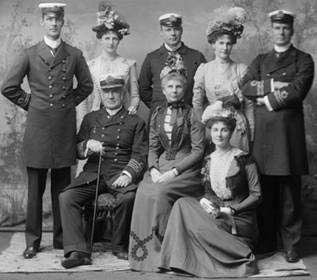Sub Lieutenant Francis Hixson

By Ruth Teale
Francis Hixson (1833-1909), naval officer and public servant, was born on 8 January 1833 at Swanage, Dorset, England, son of William Hixson, master mariner, and his wife Annie, née Manwell. He joined the Navy and in February 1848 as master's assistant in the Havannah, helped to survey parts of the Australian east coast, New Zealand and the South Seas and returned to England in December 1851. He then served in the HMS Impregnable and in February 1852 joined the Herald in the expedition to survey and take possession of New Caledonia. They arrived to find the French already in occupation so they surveyed among the Fijian islands and along the Australian coast and went to Sydney. In 1855 Hixson became acting second master. In 1858 he won the Silver Medal of the Royal Humane Society for the rescue of a drowning seaman. Three months after the Herald's cruise ended at Sydney in May 1860 Hixson was awarded his master's certificate. Next year the Herald reached England in July. He served in the Pelorus in 1861 and in the Orpheus in 1862 on surveys of the New South Wales coast. Hixson's log books reveal him as an able master with scientific attainments and curiosity, and as a keen observer of society in the South Pacific.
On 1 January 1863 Hixson resigned and was appointed Superintendent of Pilots, Lighthouses and Harbours in New South Wales. These duties were incorporated in April 1872 as the Marine Board of New South Wales with Hixson as its President; when it was abolished in March 1900 none of his decisions had been reversed by the Board of Trade. He was co-opted for other posts: member of the Fisheries Commission, the Defence from Foreign Aggression Commission and the Board for Maintaining Colonial Warlike Stores in 1870 and Chairman of the Pilot Board; he was chosen to establish an observatory at Goulburn to observe the transit of Venus in 1874. He advocated the building of more lighthouses, claiming that he wanted the coast 'illuminated like a street with lamps'. In 1893 and 1898 he represented the colony at marine conferences in Hobart and New Zealand.
Hixson was best known for his work with the Volunteer Naval Brigade. Its numbers steadily increased after he took command. In the 1880s an artillery unit was added and after a visit to England he reorganised the colony's naval forces. In the Boxer Rebellion of 1900 he took a contingent to Hong Kong where the RN took over. For forty years he had been chairman of the Sailors' Home in Sydney; he also served on the Committee of the Royal Naval House, helped to found the Royal Shipwreck Relief, was President of the Humane Society of New South Wales and took great interest in the Vernon, a training ship for the rehabilitation of orphan boys.
On 2 November 1861 at St Thomas' Church, North Sydney, Hixson married Sarah, second daughter of Francis Lord. He died of heart failure at his home in Double Bay on 2 March 1909 and was buried with naval honours. He was survived by his wife, three sons who had also been active in the naval brigade, and three daughters, two of whom married grandsons of John Fairfax.
Image: Hixson family, circa 1898
State Library of NSW collection


